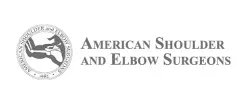There has been a trend in recent years to reduce the amount of metal necessary to achieve solid implant fixation in the bone during total shoulder replacement. Traditional long titanium stems (picture to the right), when they engage the outer hard shell of bone, can result in a phenomenon called stress shielding. This is when the forces transmitted through the joint travel through the metal. When the bone around the implant does not experience stress, it weakens and sometimes disappears. Some stem designs can result in substantial loss of the upper part of the humerus bone in response to stress shielding. This can be concerning because if eventual revision surgery is needed, stem removal can lead to major destruction of supporting bone.
This picture demonstrates significant stress shielding due to abundant contact of this short stem. The bone where the orange arrow is pointing has resorbed due to a lack of stress transfer. Eventually, this can lead to stem loosening and the need for revision surgery. As design surgeons and engineers have come to understand this problem, the industry has designed newer implants, including both short stem and stemless options, that minimize bone contact. By reducing the amount of metal in contact with bone or avoiding contact with the outer wall of bone together, stress shielding can be avoided while still providing an anatomic reconstruction and immediate solid fixation.
This example shows an Exactech short Preserve stem used in a reverse shoulder replacement. It can be used in both anatomic and reverse cases. Unlike its cousin, the traditional long stem, this is designed so that smaller stems can achieve stability without engaging the sides of the bone. If this stem looks undersized relative to the patient’s humerus, it is intended this way. By eliminating contact with the walls, the stress is born by the bone and not the implant. These stems can be used in a majority of cases except patients with substantial osteoporosis.
This example shows a stemless design. As in a stemmed design, the head is resected and the underlying bone is prepared for the implant. Fixation is achieved by the circular cage which allows the bone to weld itself to the pores in the outer surface of the metal, as well as to grow through the holes. The same head sizes can be used as in a traditional or short stem design. This cage can be positioned optimally in the bone to ensure the best restoration of a patient’s anatomy. These can only be used to standard shoulder replacements and not for reverse shoulder replacements.
This example shows a resurfacing head. This acts more like a cap. The original head is not resected but the cartilage is reamed away. The reamed bone is then covered with the metal head which is impacted on like a thumbtack. The cage also provides immediate stability. Like the stemless, these implants cannot be used in osteoporotic bone. These too can only be used for standard shoulder replacements. I commonly use them in Ream and Run procedures. They are easy to revise if necessary and maximally bone preserving. Access to the socket can be challenging in some patients because the humeral head is not resected.
All of these stem options have their place in shoulder replacement. The critical factor is to choose the best stem for each individual case that balances immediate fixation in the bone, implant durability, bone preservation and one that can provide revision options if necessary at a later date. Using a system with a wide variety of options like this provides surgeons with ample tools to achieve excellent outcomes. An experienced shoulder surgeon will know how and when to use each of these for the best benefit of the patient.
Learn more about a Total Shoulder Replacement at King and Parsons.


















